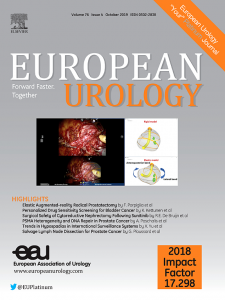Bridging Evidence Gaps in Upper Tract Urothelial Carcinoma: Divergent Strategies Between the American Urological Association and European Association of Urology Guidelines
IF 25.2
1区 医学
Q1 UROLOGY & NEPHROLOGY
引用次数: 0
Abstract
Section snippets
Imaging
The EAU guidelines recommend fluorodeoxyglucose (FDG) positron emission tomography (PET) imaging (weak recommendation) as a first-line staging modality in high-risk cases. By contrast, the AUA takes a more conservative position in only recommending FDG PET when standard computed tomography (CT) or magnetic resonance imaging is not feasible.Ureteroscopy
The role of ureteroscopy (URS) differs between the two guidelines. While the AUA guidelines strongly recommend URS with biopsy as a standard diagnosticDiscussion
The management of UTUC remains challenging owing to the limited high-quality data available. Both the AUA and EAU have provided robust evidence-based guidelines on UTUC, but nuanced differences that may have clinical significance are evident from a side-by-side comparison, as summarized in Table 1.Accurate staging remains a cornerstone of UTUC management, particularly given its role in risk stratification. Conventional CT shows low sensitivity of 25% (95% confidence interval [CI] 20–31%), but弥合上尿路上皮癌的证据差距:美国泌尿外科协会和欧洲泌尿外科协会指南的不同策略
EAU指南推荐氟脱氧葡萄糖(FDG)正电子发射断层扫描(PET)成像(弱推荐)作为高危病例的一线分期方式。相比之下,当标准计算机断层扫描(CT)或磁共振成像不可行时,AUA只推荐FDG PET,这一立场更为保守。输尿管镜检查输尿管镜检查(URS)的作用在两个指南中有所不同。虽然AUA指南强烈推荐URS活检作为标准诊断,但由于可用的高质量数据有限,UTUC的管理仍然具有挑战性。AUA和EAU都为UTUC提供了强有力的循证指南,但从并排比较中可以明显看出可能具有临床意义的细微差异,如表1所示。准确的分期仍然是UTUC管理的基石,特别是考虑到它在风险分层中的作用。常规CT显示25%的低灵敏度(95%置信区间[CI] 20-31%)
本文章由计算机程序翻译,如有差异,请以英文原文为准。
求助全文
约1分钟内获得全文
求助全文
来源期刊

European urology
医学-泌尿学与肾脏学
CiteScore
43.00
自引率
2.60%
发文量
1753
审稿时长
23 days
期刊介绍:
European Urology is a peer-reviewed journal that publishes original articles and reviews on a broad spectrum of urological issues. Covering topics such as oncology, impotence, infertility, pediatrics, lithiasis and endourology, the journal also highlights recent advances in techniques, instrumentation, surgery, and pediatric urology. This comprehensive approach provides readers with an in-depth guide to international developments in urology.
 求助内容:
求助内容: 应助结果提醒方式:
应助结果提醒方式:


